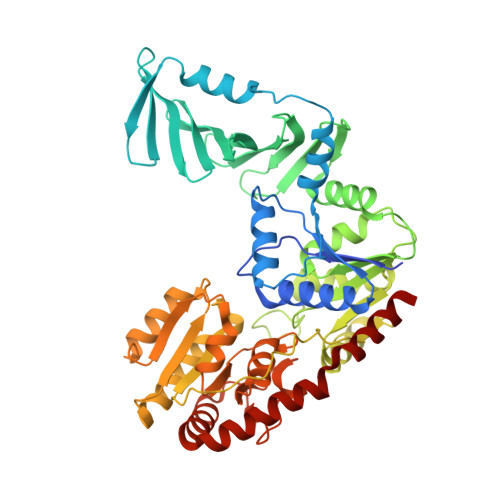Invasive Staphylococcus epidermidis uses a unique processive wall teichoic acid glycosyltransferase to evade immune recognition.
Guo, Y., Du, X., Krusche, J., Beck, C., Ali, S., Walter, A., Winstel, V., Mayer, C., Codee, J.D.C., Peschel, A., Stehle, T.(2023) Sci Adv 9: eadj2641-eadj2641
- PubMed: 38000019
- DOI: https://doi.org/10.1126/sciadv.adj2641
- Primary Citation of Related Structures:
7QD7, 7QH9, 7QNT, 8P1X, 8P20 - PubMed Abstract:
Staphylococcus epidermidis expresses glycerol phosphate wall teichoic acid (WTA), but some health care-associated methicillin-resistant S. epidermidis (HA-MRSE) clones produce a second, ribitol phosphate (RboP) WTA, resembling that of the aggressive pathogen Staphylococcus aureus . RboP-WTA promotes HA-MRSE persistence and virulence in bloodstream infections. We report here that the TarM enzyme of HA-MRSE [TarM(Se)] glycosylates RboP-WTA with glucose, instead of N -acetylglucosamine (GlcNAc) by TarM(Sa) in S. aureus . Replacement of GlcNAc with glucose in RboP-WTA impairs HA-MRSE detection by human immunoglobulin G, which may contribute to the immune-evasion capacities of many invasive S. epidermidis . Crystal structures of complexes with uridine diphosphate glucose (UDP-glucose), and with UDP and glycosylated poly(RboP), reveal the binding mode and glycosylation mechanism of this enzyme and explain why TarM(Se) and TarM(Sa) link different sugars to poly(RboP). These structural data provide evidence that TarM(Se) is a processive WTA glycosyltransferase. Our study will support the targeted inhibition of TarM enzymes, and the development of RboP-WTA targeting vaccines and phage therapies.
Organizational Affiliation:
Interfaculty Institute of Biochemistry, University of Tübingen, Tübingen, Germany.


















